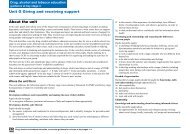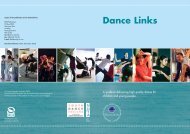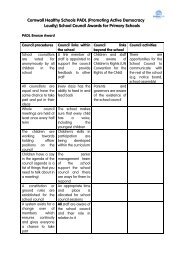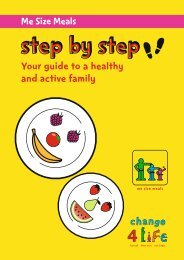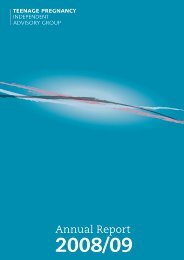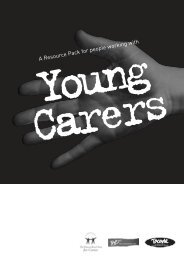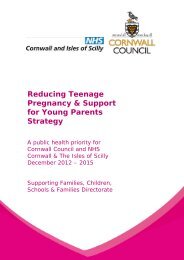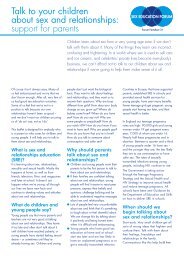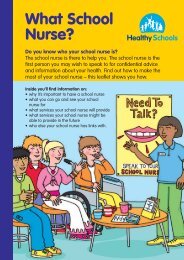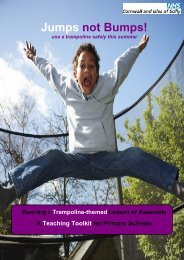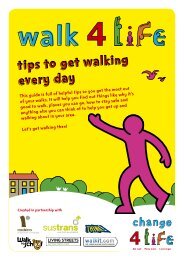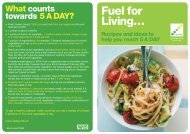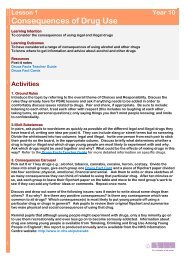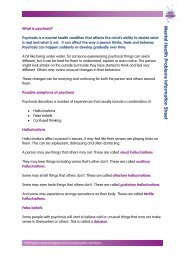Year 11 Lesson Plan - Cornwall Healthy Schools
Year 11 Lesson Plan - Cornwall Healthy Schools
Year 11 Lesson Plan - Cornwall Healthy Schools
You also want an ePaper? Increase the reach of your titles
YUMPU automatically turns print PDFs into web optimized ePapers that Google loves.
<strong>Lesson</strong> 1 <strong>Year</strong> <strong>11</strong><br />
Influences on Behaviour<br />
Learning Intention<br />
To recognise the influences and pressures on young people in relation to drug use<br />
Learning Outcomes<br />
To have considered some of the influences on a young person’s attitude to drugs and alcohol<br />
To have explored how certain social habits can lead to dependency and addiction<br />
Resources<br />
Drug Picture Cards<br />
Drugs Facts Teacher Guide<br />
Drug Related Behaviour Cards<br />
Steps to Dependency Cards<br />
Activities<br />
1. Ground Rules<br />
Introduce the topic by briefly referring to the overall theme of Impact on Adult Life. Ask the class<br />
questions to help establish ground rules for these lessons. Discuss the rules they already have for<br />
PSHE lessons and group discussions, and ask what rules would help them to feel comfortable to<br />
discuss issues related to drugs and personal relationships. Pair and share, if appropriate. Be sure<br />
to include: listening to each other, treat each other with respect (this includes no laughing at each<br />
other, taking turns, no personal questions); only saying things you don’t mind people knowing; and<br />
limits to confidentiality.<br />
2. Drugs Championship<br />
In teams of four, give each group one of the Drug Picture Cards. Each team has two minutes to<br />
create four key facts or clues for the drug on their card. Each team takes it in turn to read out their<br />
four facts or clues and the other teams have to try to guess which drug they are describing. Refer to<br />
the Drugs Facts Teacher Guide for information.<br />
Write the names of the drugs mentioned in the championship activity up on the board. Invite pupils<br />
to think of any additional drugs which might be used by young people. Have a short discussion to<br />
establish:<br />
Which are legal and which are illegal drugs?<br />
What might be seen as the positive effects of drinking or taking drugs?<br />
What risks/effects are there for young people drinking or taking drugs?<br />
Although many young people are likely to experiment with some form of drug, whether it’s drinking,<br />
smoking or illegal drugs, there are also those who don’t. The reasons why young people make these<br />
different choices will be explored in the next part of the lesson.<br />
3. Sources of influence<br />
Give pupils a piece of paper each and ask them to draw round their hand. The five digits represent<br />
five key influences on a person’s life. Ask them to do a one minute pair and share to identify who or<br />
what might influence a 16 year old’s attitude to taking drugs – for example, family, friends, culture,<br />
the media, a GP, the law, religion, sports coach etc. Write these onto their drawing. Hold a quick<br />
voting activity to identify which influences pupils think are the strongest.
<strong>Lesson</strong> 1: continued <strong>Year</strong> <strong>11</strong><br />
Influences on Behaviour<br />
4. Recognising Behaviour Continuum<br />
Explain that there is a recognised pattern for how people’s habits can develop into addiction: display<br />
the following four stages on the whiteboard and ensure everyone understands the definitions:<br />
1. Experimenting e.g. first few times someone tries smoking, drinking or taking drugs<br />
2. Recreational drinking or drug use e.g. sometimes having a drink or smoking cannabis at a party,<br />
with friends or relations<br />
3. Recreationally dependent e.g. someone drinking or taking drugs every time they go to a party or<br />
get together with friends or relations<br />
4. Dependent/addicted e.g. someone who is physically and/or psychologically addicted to a<br />
particular drug or drugs and cannot control their intake.<br />
Pin the four Steps to Dependency Cards in sequence around the room or along the floor to represent<br />
a continuum. Distribute a selection of the Drug Related Behaviour Cards to each table. Ask pupils<br />
to read through the different cards on their table. Choose a pupil to read out one of the statements<br />
and then place the card against the number on the continuum s/he thinks best relates to the<br />
behaviour described and give a reason why. Repeat the process until each situation has been<br />
assigned to the continuum.<br />
Discuss which people from the first three stages seem most likely to become more dependent and<br />
why. Who or what is likely to influence their behaviour? Would the person’s age make a difference?<br />
What might change as we grow older? Reflect that there are usually a number of different factors<br />
which influence a change in behaviour – it is rarely one person or one event but nearly always a<br />
combination or a culmination of factors.<br />
5. Review and Close<br />
Explain that the number of young people who choose not to drink or take drugs is increasing and<br />
young people are less tolerant of people their age who drink or take drugs to excess. For example,<br />
in 2010, 32% agreed that it was OK for someone of their age to drink alcohol once a week, compared<br />
with 46% in 2003. Over the same period, the proportion who thought it OK for someone of their age<br />
to get drunk once a week also fell from 20% to <strong>11</strong>%.<br />
Review the learning outcomes and ask pupils to finish with a closing round One reason why a young<br />
person chooses not to use drugs is ...<br />
Le<br />
In<br />
Additional Activities<br />
Diamond 9<br />
The aim of this activity is to explore the reasons why most young people do not take drugs. In pairs,<br />
give out a set of Diamond 9 Cards. Ask them to arrange the cards in a diamond shape, with the top<br />
card being the most common reason young people might give and the less common reasons forming<br />
the rows below. Alternatively, pupils could have their own ideas and create their own set of nine<br />
cards, which they can then rank in order. Invite each pair to feedback their top three reasons and<br />
write these on the board. Ask pupils to share some of the reasons that were at the bottom end of<br />
their diamond ranking.<br />
Agree or Disagree<br />
Label one side of the room ‘Strongly Agree’ and label the other side ‘Strongly Disagree’. Read out<br />
one of the Attitude Statements below and ask pupils to decide how they feel about the statement by<br />
moving to one side of the room or the other. Encourage pupils to explain their viewpoint. Repeat the<br />
process with up to five more statements.
<strong>Lesson</strong> 1: continued <strong>Year</strong> <strong>11</strong><br />
Influences on Behaviour<br />
Attitude Statements<br />
1. There is something wrong with young people who take drugs<br />
2. Drug use can be fun<br />
3. More men use drugs than women<br />
4. Using drugs is a normal part of growing up<br />
5. The media encourages young people to take drugs<br />
6. If your parents drink a lot, you will drink a lot<br />
7. Alcohol and cigarettes are just as bad as illegal drugs<br />
8. If your friends are trying drugs, you have to try them too<br />
9. A relationship won’t last if one person uses drugs and the other one doesn’t<br />
10. There’s no point in going to a nightclub if you don’t drink or take drugs<br />
Refer to the Drugs Facts Teacher Guide for factual information relevant to the above statements.
<strong>Lesson</strong> 2 <strong>Year</strong> <strong>11</strong><br />
Impact on Society<br />
Learning Intention<br />
To explore the impact of drinking and drug use on different sectors of society<br />
Learning Outcomes<br />
To have considered the impact of drinking and drug use on different groups of people<br />
To understand some of the laws relating to licensing and drug use and why they exist<br />
Resources<br />
Interviews from The Adventures of Pablo : http://www.talktofrank.com/adventures-of-pablo<br />
Impact Photo Cards<br />
It’s the Law Quiz Sheet<br />
It’s the Law Quiz Answers<br />
It’s the Law Quiz whiteboard summary<br />
Drugs Facts Teacher Guide<br />
Activities<br />
1. Ground Rules<br />
Remind the class of the ground rules agreed in the previous lesson and ask pupils to recall the<br />
issues that were covered.<br />
2. Introduction<br />
Display the learning outcomes on the board and explain that this lesson will aim to explore how many<br />
different people are involved in, and affected by, drinking and drug use. Use one or two short video<br />
clips to demonstrate a different perspective of drug use and who it affects. E.g. the interviews with<br />
the Colombian Minister and the Drugs Worker on The Adventures of Pablo section on the Talk to<br />
Frank website http://www.talktofrank.com/adventures-of-pablo. Alternatively, bring in a selection of<br />
objects which relate to the production and use of alcohol or drugs (e.g. leaf, toy aeroplane, drinking<br />
straw, truncheon, stethoscope) and ask pupils to work out what each item represents (i.e. coca leaf,<br />
smuggling, use of cocaine, policing, medical treatment).<br />
3. Impact Photos<br />
Distribute the Impact Photo Cards so that every pupil has one photograph each. Explain that there<br />
are four different groups represented by the people in the photos who are all affected by drug use in<br />
some way: business and trade, the law, drug users and treatment and care. The photos represent:<br />
<br />
<br />
<br />
<br />
Business and trade: farmer (coca, hops, tobacco), brewer, pub landlord, drug dealer,<br />
off-licence owner<br />
The law: customs officer, police officer, judge, bouncer, politician<br />
Drug users: drinker, smoker, cannabis user, cocaine user, heroin addict, clubber/raver<br />
Treatment and care: ambulance paramedic, doctor, drugs worker, social worker, parents<br />
Ask pupils to circulate and form a group with people whose photos they think represent the other<br />
members of their category. Alternatively, call out each category and ask pupils to say if they think<br />
they belong in that group. Each group should have roughly the same number of people. Ask the<br />
groups to consider the following:<br />
Role of person?<br />
How are they affected by drug use/someone’s habit?<br />
How much power/control do they have?<br />
Ask pupils to feedback key points from their discussion. Reflect that some drug users think their<br />
habit isn’t harming or affecting anyone else, whereas in fact usually the opposite is true.
<strong>Lesson</strong> 2 : continued <strong>Year</strong> <strong>11</strong><br />
Impact on Society<br />
4. It’s the Law Quiz<br />
Ask the class to complete the It’s the Law Quiz Sheet, individually or in pairs. Discuss the answers<br />
as a whole group using the It’s the Law Quiz Whiteboard Summary. Alternatively, use the Quiz<br />
Busters tool, described in Additional Activities below, to create a tailored version of the<br />
Blockbusters TV game. Further information about drugs and the law is provided in the Drugs Facts<br />
Teacher Guide.<br />
5. Review and Close<br />
Closing round: ‘One new law I have learnt about today is......’<br />
Additional Activities<br />
Quiz Busters<br />
Use the Quiz Busters tool, which is a tailored version of the Blockbusters TV game, as a starter<br />
activity. There is a general quiz for drug awareness or link it to a theme of your own, e.g. the law on<br />
drugs. It is available free from the Teachers Direct website:<br />
http://www.teachers-direct.co.uk/resources/quiz-busters/subjects/ks4/personal,-social-and-healtheducation.aspx<br />
Legalise It Debate<br />
Use the Debatepedia website<br />
http://debatepedia.idebate.org/en/index.php/Debate:_Legalization_of_drugs<br />
to support pupils to hold a debate on the legalisation of drugs. The site provides a balanced view of<br />
the different points which might be made in such a debate including:<br />
<br />
<br />
<br />
<br />
<br />
<br />
Does the individual have the right to consume drugs?<br />
Is drug-use morally acceptable or tolerable?<br />
Would legalization decrease drug-consumption?<br />
Could/should the state make drug-consumption safer?<br />
Is it a good idea to legalize and tax drugs?<br />
Would legalization reduce crime and the presence of gangs?<br />
Film about Drug Smuggling<br />
Maria Full of Grace is a film with a 15 certificate rating, which explores the dangers and dilemmas<br />
faced by three women who become drug mules to smuggle cocaine out of Colombia in order to earn<br />
much needed money for their families.
<strong>Lesson</strong> 3 <strong>Year</strong> <strong>11</strong><br />
Personal Relationships<br />
Learning Intention<br />
To consider how drugs and alcohol can affect personal relationships<br />
Learning Outcomes<br />
To understand what constitutes controlling or abusive behaviour in a relationship<br />
To have identified some sources of advice and support for domestic abuse situations<br />
Resources<br />
Love or Control? Statement Cards<br />
Relationship Scenario Cards<br />
Relationship Scenario Question Sheet<br />
Drugs Facts Teacher Guide<br />
Activities<br />
The activities in this lesson address sensitive issues which may affect young people in different ways<br />
depending on their personal circumstances. If unsure about delivering certain parts of the session<br />
we recommend you discuss this with colleagues, especially the Safeguarding Lead.<br />
1. Ground Rules<br />
Remind the class of the ground rules agreed in the previous lesson.<br />
2. Learning Outcomes<br />
Recap the learning from the previous session and explain that this session will focus in on how<br />
drinking and drug use can affect personal relationships. The class will consider what constitutes<br />
controlling behaviour in a relationship and practise offering advice to people whose relationships<br />
might be in trouble.<br />
3. Love or Control?<br />
Briefly explore what is meant by controlling behaviour: ask why a person may want to take control of<br />
a relationship and why a partner might allow this to happen. Ask pupils to suggest possible signs of a<br />
healthy relationship and an unhealthy relationship. Initial signs of controlling behaviour might start<br />
with a person constantly checking up on their partner’s behaviour e.g. Where did you go last night?<br />
Who did you see? Who was that text from? Comments might take the form of put-downs You’re a bit<br />
overdressed You’re not going out in that are you? A positive relationship should enable each person<br />
to feel good about themselves and give each other confidence. Jealous or controlling behaviour,<br />
particularly in the early stages of a relationship, will chip away at a person’s self-esteem and<br />
confidence, resulting in increased isolation from friends and family.<br />
Divide the class into small groups and give each group a set of Love or Control? Statement Cards.<br />
Ask pupils to consider each statement and sort the cards into three piles: ‘controlling behaviour’,<br />
‘loving behaviour’, and ‘depends’. Discuss any statements which pupils have put in their ‘depends’<br />
pile. Reflect that it is usually fear and a person’s own insecurities, which make them behave in a<br />
controlling way with their partner.<br />
4. Relationship Scenarios<br />
Explain that this next activity will give pupils the opportunity to practise giving advice about<br />
relationships and to identify possible sources of advice and support. In pairs, distribute one<br />
Relationship Scenario Card to each pair; use only the ‘A’ scenarios to start with (i.e. Alisha, Rob,<br />
Lauren, Mike and Sarah). Ask pupils to discuss the scenario and complete the Relationship Scenario<br />
Question Sheet to identify the positive and negative areas in the relationship and decide what advice
<strong>Lesson</strong> 3: continued <strong>Year</strong> <strong>11</strong><br />
Personal Relationships<br />
they would give this person. Then give each pair their matching ‘B’ scenario card and ask them to<br />
discuss whether this information changes their view of the relationship and the advice they would<br />
give. Ask pupils to feedback key points from their discussion.<br />
Reflect that equal respect is the key to a happy and healthy relationship. Encourage pupils to be<br />
alert to the warning signs early on in the relationship and talk to someone about it if they’re not sure.<br />
Identify possible sources of advice and support for relationship problems; this might include the<br />
following:<br />
<br />
<br />
<br />
<br />
<br />
Pastoral Support Teacher<br />
School Nurse<br />
Family Support Worker<br />
Childline has a free 24 hour advice line 0800 <strong>11</strong><strong>11</strong> and website www.childline.org.uk<br />
The Women’s Aid website has a section about domestic abuse specifically for teenagers<br />
called the Hideout: http://www.thehideout.org.uk/over10/default.aspa<br />
Details of other national organisations providing support are listed in the Drugs Facts Teacher Guide.<br />
5. Review and Close<br />
Summarise the learning for the lesson and review the learning outcomes. Acknowledge the serious<br />
nature of the topic and finish with an upbeat closing round such as ‘One of the great things about<br />
being in a relationship is....’<br />
Additional Activities<br />
<strong>Healthy</strong> and Unhealthy Relationships<br />
Ask the class to write ideas on post-its about what they think makes a healthy or an unhealthy<br />
relationship; one idea per post-it. Create two columns on the board, one headed ‘<strong>Healthy</strong><br />
Relationship’, the other headed ‘Unhealthy Relationship’. Invite pupils to stick their post-its on the<br />
board in the appropriate column. Challenge and summarise the two columns and pick out a couple of<br />
statements from each column to discuss in more detail.<br />
Domestic Abuse and the Law<br />
The Expect Respect Toolkit has a quiz about sexual harassment and criminal liability, as well as a<br />
range of other activities on domestic abuse for all year groups. It is available free to download in the<br />
Free Resources section on the Women’s Aid website: http://www.womensaid.org.uk<br />
Alcohol and Violence<br />
There is a short video clip by TV Fixers about alcohol and the possible consequences of aggressive<br />
behaviour on a friends’ night out, available on the Stand Against Violence website: http://www.saved.co.uk/Awareness-Advert.htm.<br />
There is also a DVD available to buy about a true story of a young<br />
man who died as a result of alcohol fuelled violence. http://www.save-ed.co.uk.



